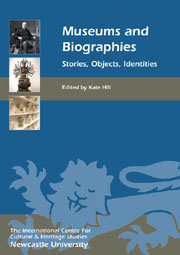Book contents
- Frontmatter
- Contents
- List of Illustrations
- Introduction: Museums and Biographies – Telling Stories about People, Things and Relationships
- INDIVIDUAL BIOGRAPHY AND MUSEUM HISTORY
- PROBLEMATISING INDIVIDUALS' BIOGRAPHIES
- INSTITUTIONAL BIOGRAPHIES
- 7 Significant Lives: Telling Stories of Museum Architecture
- 8 Schinkel's Museums: Collecting and Displaying Architecture in Berlin, 1844–1933
- 9 Personifying the Museum: Incorporation and Biography in American Museum History
- 10 Making an Exhibition of Ourselves
- 11 Institutional Autobiography and the Architecture of the Art Museum: Restoration and Remembering at the National Gallery in the 1980s
- OBJECT BIOGRAPHIES
- MUSEUMS AS BIOGRAPHY
- MUSEUMS AS AUTOBIOGRAPHY
- Endpiece: The Homunculus and the Pantograph, or Narcissus at the Met
- List of Contributors
- Index
8 - Schinkel's Museums: Collecting and Displaying Architecture in Berlin, 1844–1933
from INSTITUTIONAL BIOGRAPHIES
Published online by Cambridge University Press: 05 February 2013
- Frontmatter
- Contents
- List of Illustrations
- Introduction: Museums and Biographies – Telling Stories about People, Things and Relationships
- INDIVIDUAL BIOGRAPHY AND MUSEUM HISTORY
- PROBLEMATISING INDIVIDUALS' BIOGRAPHIES
- INSTITUTIONAL BIOGRAPHIES
- 7 Significant Lives: Telling Stories of Museum Architecture
- 8 Schinkel's Museums: Collecting and Displaying Architecture in Berlin, 1844–1933
- 9 Personifying the Museum: Incorporation and Biography in American Museum History
- 10 Making an Exhibition of Ourselves
- 11 Institutional Autobiography and the Architecture of the Art Museum: Restoration and Remembering at the National Gallery in the 1980s
- OBJECT BIOGRAPHIES
- MUSEUMS AS BIOGRAPHY
- MUSEUMS AS AUTOBIOGRAPHY
- Endpiece: The Homunculus and the Pantograph, or Narcissus at the Met
- List of Contributors
- Index
Summary
The story of architecture museums in Berlin is, in one sense, a short one. Although Berlin's collection of archives dedicated to architecture is quite deep, it was only in 2007, when the Technical University renamed its archive and exhibition space after its historic Architekturmuseum, that the architecture museum as a type of institution re-established itself in the city's cultural landscape. Before this, the last time there was an architecture museum in Berlin was from 1931 to 1933. It was called the Schinkel Museum, and its short lifespan is surprising, given that Karl Friedrich Schinkel (1781–1841) was – and still is – recognised as Prussia's most famous architect. As the head of the Prussian Oberbaudeputation (the State architectural administration), Schinkel built an extraordinary number of public projects in addition to his private commissions, namely villas and commercial buildings. But he was most notable for ‘giving Berlin a face’ after the Napoleonic Wars, transforming it from a military garrison into a capital city. His urban design for the area around Unter den Linden unified the boulevard and added urban spaces from which people could behold several of his masterpieces: the Neue Wache (1816–18); the Schauspielhaus (1819–21); the Altes Museum (1823–30); and the Bauakademie (1832–36).
Of course, the short and complex story of architecture museums does not end here. First of all, it is not clear whether the Schinkel Museum can (or could have been) considered as an architecture museum at all because it was not an independent institution but part of the National Gallery.
- Type
- Chapter
- Information
- Museums and BiographiesStories, Objects, Identities, pp. 119 - 132Publisher: Boydell & BrewerPrint publication year: 2012

